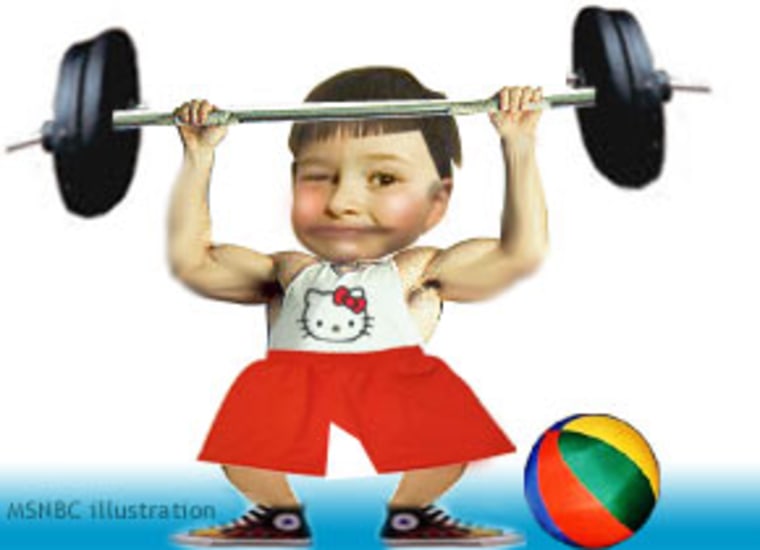Is it OK for kids to weight-train? Also, can exercise help reduce “man breasts?” Smart Fitness answers your queries. Have an exercise question? Send it to smartfitness@msnbc.com. We’ll post select answers in future columns.
Question: My 10-year-old son is thin and would like to start weight-lifting in order to bulk up for sports. When I was young I was told that kids shouldn’t start strength-training until their bones have stopped growing. Is this still accepted wisdom?
Answer: No, experts say, though such myths abound, including the notion that strength-training will stunt a child’s growth.
“There are no data to back up those assertions,” says Dr. Jorge Gomez, who participated in an American Academy of Pediatrics panel that devised guidelines on strength-training for kids.
Organizations such as the AAP and the American College of Sports Medicine agree that strength-training for children and adolescents can be safe and effective, as long as appropriate precautions are taken.
“It’s really quite safe, but injuries can result from lack of supervision or trying to lift too much weight,” says Dr. Jordan Metzl, medical director of the Sports Medicine Institute for Young Athletes at the Hospital for Special Surgery in New York City and co-author of “The Young Athlete: A Sports Doctor’s Complete Guide for Parents.”
In addition to strength gains from weight-training, the ACSM cites such potential benefits as building strong bones, improving coordination and sports performance, preventing sports injuries, boosting confidence and self-esteem, and encouraging a healthy lifestyle.
Keep expectations low
Your son will need to temper his expectations though: He won’t be able to build significant muscle bulk until adolescence.
“A 10-year-old cannot body-build,” points out Avery Faigenbaum, an associate professor of exercise science at the University of Massachusetts in Boston.
Until your son hits puberty and his body starts churning out testosterone, he won’t be able to significantly increase the size of his muscles. But he and other preadolescent youngsters can still become stronger from strength-training because of so-called neuromuscular learning, in which the body gradually makes better use of existing muscle.
“They are training their bodies to recruit muscle fibers to perform a certain activity,” explains Faigenbaum, co-author of “Strength & Power for Young Athletes.”
While he instructs some children as young as 6 or 7 in strength-training, he says older kids are generally better able to follow instructions and perform the activities safely.
“Ages 8 to 9 or 10 are good times to start weight-training, twice per week,” Faigenbaum says.
Proper technique is essential
Learning proper technique and safety practices are essential, experts stress, and a qualified adult should always be present.
“Supervision is of the utmost importance,” says Faigenbaum. He recommends kids work with an experienced trainer, such as a physical education teacher at school or a qualified youth instructor at a YMCA or other recreation center.
Muscle strains are cited as the most common risk among kids — and adults — who strength-train. But sloppy technique or horsing around can lead to more serious problems, such as injuries from dropped weights.
To prevent injuries, it’s recommended that children start off with very low weight until they learn good form, then slowly add more resistance. If a child can’t lift a particular weight at least six times in a row, it’s too heavy, experts say.
Kids should never “max out” — lifting super-heavy weights — or engage in fast, jerky movements like competitive weight-lifters do. Instead, they should focus on slow, controlled movements with light to moderate weight loads.
Strength-training can be done with free weights, child-size weight machines, resistance bands and one’s own body weight (e.g. push-ups, sit-ups and squats). But kids may not be able to safely use adult weight machines because they may be too big or the starting weights too heavy.
While a strengthening regimen can be a safe, positive experience for kids, it should not replace aerobic activities like bike riding or playing tag, says Gomez, an associate professor of pediatrics and sports medicine at the University of Texas Health Science Center in San Antonio. With a growing obesity epidemic among kids, it’s very important they get regular aerobic activity to burn calories and stay healthy, he says.
Strength-training should also be something that, along with other types of physical activity, kids enjoy.
“You want kids to be active,” Gomez says, “and they’re not going to be active if it’s not fun for them.”
Breast reduction — for men
Question: Can exercise help minimize “man breasts?”
Answer: Just as exercise can help burn fat in other areas of the body, it can reduce the accumulation of fat in the upper torso — one likely cause of “man breasts.”
“It is relatively common for men to store excess fat in the abdominal and chest areas, particularly as they age,” says Cedric X. Bryant, chief exercise physiologist at the American Council on Exercise, a nonprofit group in San Diego.
While experts say it’s impossible to “spot reduce” — lose weight in just one particularly area — you can embark on a diet and exercise program to help you lose weight overall. In doing so, you should shed fat in your chest as well.
Strength-training exercises such as the chest press and pectoral fly can help you build up the underlying muscle in your chest, Bryant notes. But you’ll need regular aerobic exercise, like jogging or biking, to burn off the fat layer on top of that muscle.
In some cases, men can develop a condition known as gynecomastia, in which the breasts become enlarged due to such factors as liver disease or kidney failure, certain medications or use of steroids to build muscle. Teen-age boys may also experience temporary gynecomastia as they go through the hormonal changes of adolescence.
If you’re concerned the breast enlargement may be due to something other than weight gain, consult your doctor.
